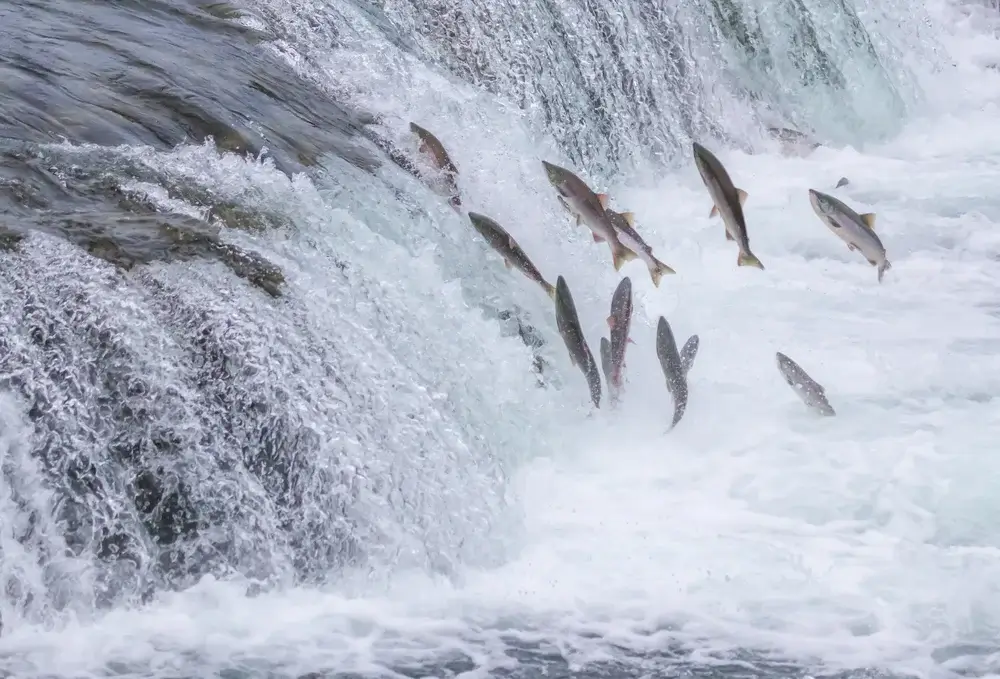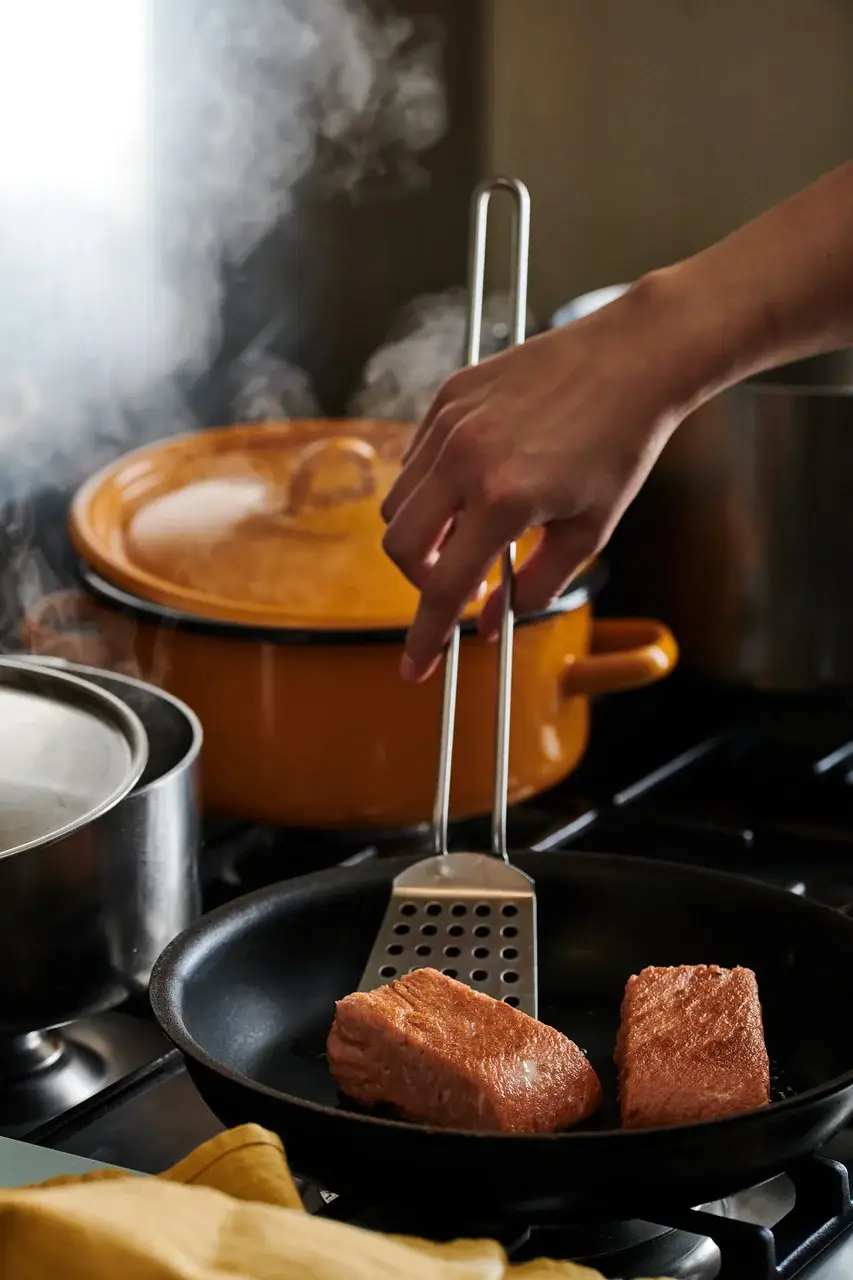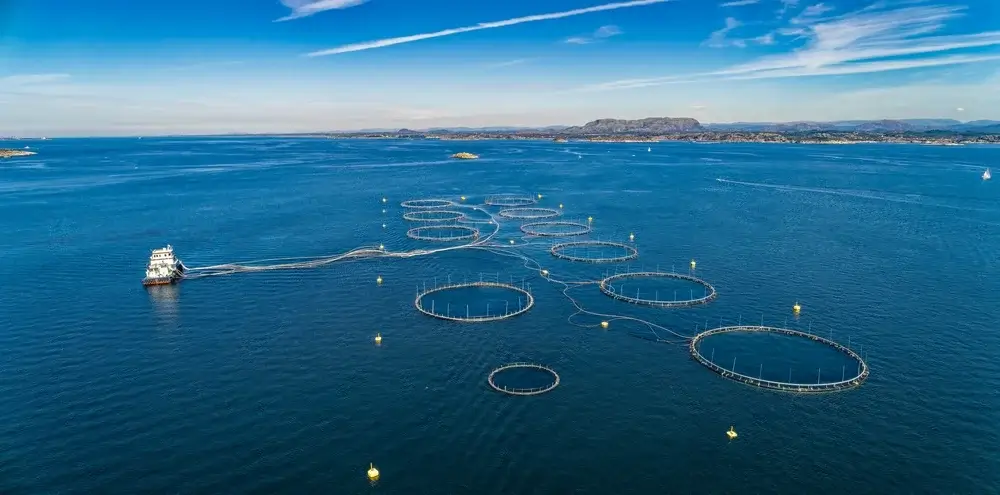Farmed, Wild, Lab Grown, or Plant-Based: Which Salmon is Best?
If you’re seeking salmon, here are some things to consider when buying your catch.
Farmed, Wild, Lab Grown, or Plant-Based: Which Salmon is Best?
If you’re seeking salmon, here are some things to consider when buying your catch.

Photography via Shutterstock/Sekar B.
The sight of wild salmon coursing upstream through a river during spawning season is one often used to convey the essence of wilderness through media; I’ve seen spawning salmon imagery in film, on TV, and even in a Geico commercial. However, it’s a sight that few Americans who consume salmon will ever see—and maybe that’s where the issue starts. Our removal from this primal origin of our food is pushing consumption rates to their limits.
Americans crave salmon; the salmon industry is valued at over $14 billion, and even in less-than-ideal economic scenarios, families are willing to fork over the approximate $13 to $23 per pound for this pricey but versatile fish. With consumption rates of salmon rising, the industry is growing volatile as it becomes clear that both wild-caught and farmed salmon cause environmental and economic issues.
READ MORE
California’s salmon are teetering on the brink of survival. Can we get out of their way?
Salmon have been historically overfished, and they are now endangered in many of the rivers they used to flood during their annual migration. NOAA Fisheries determined in 2018 that five Pacific salmon stocks are now “overfished” and one stock is “subject to overfishing,” including Chinook and coho salmon.

In light of the environmental dangers of wild salmon, farmed salmon may sound like an ideal solution; propagating salmon to be eaten without being removed from the wild should both help populations and consumers, right? Sadly, farmed salmon is rarely ever environmentally neutral. In fact, the industry is incredibly destructive to wild marine life, even in well-managed operations. Organizations such as Monterey Bay Aquarium’s Seafood Watch have even noted that wild-caught salmon managed in a responsible way (the population is healthy, and the fishery has little or no impact on other marine life) is almost always a lesser environmental impact than farmed salmon.

In the US, all Atlantic salmon for sale are farmed fish, with no commercial fishing allowed for this species due to the dramatic drop in population size these salmon faced after previous overfishing. Unfortunately, farmed salmon are often a threat to wild salmon. But farmed salmon, kept in large nets in waterways, are prone to escaping—and when they escape, they’re more than ready to enjoy their limited lifespans and interbreed with their wild counterparts, negatively impacting the genetic composition and fitness of native salmon populations, and sometimes introducing diseases for which wild salmon aren’t prepared. Most farmed salmon in the US are produced in marine net pens intended to contain the salmon while utilizing natural waterflow; these systems inherently impact the environment. Even if no salmon were to escape, farmed salmon pollute the waters they inhabit with waste and chemicals used to combat disease and parasites.
What’s a salmon lover to do? Today’s shoppers are looking for new sources of salmon that won’t leave them feeling guilty when they clear their plates.

One of the rising solutions to the salmon dilemma is plant-based alternatives. Oshi is an up-and-coming brand of plant-based salmon, primarily made from soy and mycelium (a fungus usually found in blue cheese or salami).
Oshi’s salmon isn’t indistinguishable from real salmon, but its texture is very close, and it maintains a mild salmony flavor that blends into traditional salmon dishes. More importantly, Oshi’s salmon provides an option without the guilt of farmed salmon’s environmental harm. “Commercial fishing is a leading cause of overfishing, which threatens the biodiversity of our oceans, while fish farming often leads to pollution and habitat destruction,” says Ofek Ron, a representative of Oshi. “For those concerned about environmental impact, choosing plant-based salmon helps support efforts to reduce overfishing and protect marine ecosystems.” Currently, Oshi’s products are only available in local retailers around Seattle and farmer’s markets, but it has plans to expand the brand to retailers nationwide.

And, of course, there’s the most technologically advanced option for salmon lovers: lab-grown, cell-cultivated salmon. First, isolated cells are taken from juvenile Pacific salmon—a step that only needs to be completed once per species. Then, these cells are grown in large steel tanks resembling those found in breweries and fed proteins, fats, salts and minerals to help them grow. These authentic salmon cells are harvested and combined with several plant-based ingredients in order to lend them the flavor, texture and appearance of a traditional salmon filet. “While this method of making seafood may seem new, our technology would look familiar to anyone who’s visited a microbrewery,” says Justin Kolbeck, CEO of Wildtype, which produces cell-cultivated salmon. “We built our fishery in a former brewery that unfortunately didn’t make it through the pandemic. We repurposed and upgraded much of the equipment from the brewery including some mixing tanks, as well as the cooling and cleaning systems.”
LEARN MORE
The color of farmed salmon comes from an additive in their feed.
Kolbeck notes that while Wildtype isn’t yet a perfect replica of a wild-caught salmon filet, it is continually improving, and the current product is quite nutritious. “We designed our salmon to provide the same level of omega-3 fats as the most pristine wild salmon,” says Kolbeck. “We’ve learned that consumers are increasingly concerned about their exposure to toxins through the food they consume. We can offer a nutritious and delicious seafood option without the associated risk of exposure to high levels of these contaminants.”

At the global level, fish consumption is projected to increase by 14.8 percent by 2030. It’s not clear how an already stretched-thin aquaculture industry will rise to meet these demands, particularly with more public pushback on environmental damage. However, in a world already struggling with global food insecurity, overfishing, and the uncertainty of climate change, continuing “the way things have always been” simply isn’t going to work. We shouldn’t expect either farmed or wild-caught salmon to go anywhere anytime soon. As the most widespread and economically friendly options, they will still be the first choice for most consumers. But we can expect to see new options make their way into consumer’s fridges and onto menus—and our oceans will certainly be better for it.
Follow us
This work is licensed under a Creative Commons Attribution-NoDerivatives 4.0 International License.
Want to republish a Modern Farmer story?
We are happy for Modern Farmer stories to be shared, and encourage you to republish our articles for your audience. When doing so, we ask that you follow these guidelines:
Please credit us and our writers
For the author byline, please use “Author Name, Modern Farmer.” At the top of our stories, if on the web, please include this text and link: “This story was originally published by Modern Farmer.”
Please make sure to include a link back to either our home page or the article URL.
At the bottom of the story, please include the following text:
“Modern Farmer is a nonprofit initiative dedicated to raising awareness and catalyzing action at the intersection of food, agriculture, and society. Read more at <link>Modern Farmer</link>.”
Use our widget
We’d like to be able to track our stories, so we ask that if you republish our content, you do so using our widget (located on the left hand side of the article). The HTML code has a built-in tracker that tells us the data and domain where the story was published, as well as view counts.
Check the image requirements
It’s your responsibility to confirm you're licensed to republish images in our articles. Some images, such as those from commercial providers, don't allow their images to be republished without permission or payment. Copyright terms are generally listed in the image caption and attribution. You are welcome to omit our images or substitute with your own. Charts and interactive graphics follow the same rules.
Don’t change too much. Or, ask us first.
Articles must be republished in their entirety. It’s okay to change references to time (“today” to “yesterday”) or location (“Iowa City, IA” to “here”). But please keep everything else the same.
If you feel strongly that a more material edit needs to be made, get in touch with us at [email protected]. We’re happy to discuss it with the original author, but we must have prior approval for changes before publication.
Special cases
Extracts. You may run the first few lines or paragraphs of the article and then say: “Read the full article at Modern Farmer” with a link back to the original article.
Quotes. You may quote authors provided you include a link back to the article URL.
Translations. These require writer approval. To inquire about translation of a Modern Farmer article, contact us at [email protected]
Signed consent / copyright release forms. These are not required, provided you are following these guidelines.
Print. Articles can be republished in print under these same rules, with the exception that you do not need to include the links.
Tag us
When sharing the story on social media, please tag us using the following: - Twitter (@ModFarm) - Facebook (@ModernFarmerMedia) - Instagram (@modfarm)
Use our content respectfully
Modern Farmer is a nonprofit and as such we share our content for free and in good faith in order to reach new audiences. Respectfully,
No selling ads against our stories. It’s okay to put our stories on pages with ads.
Don’t republish our material wholesale, or automatically; you need to select stories to be republished individually.
You have no rights to sell, license, syndicate, or otherwise represent yourself as the authorized owner of our material to any third parties. This means that you cannot actively publish or submit our work for syndication to third party platforms or apps like Apple News or Google News. We understand that publishers cannot fully control when certain third parties automatically summarize or crawl content from publishers’ own sites.
Keep in touch
We want to hear from you if you love Modern Farmer content, have a collaboration idea, or anything else to share. As a nonprofit outlet, we work in service of our community and are always open to comments, feedback, and ideas. Contact us at [email protected].by Patrick Kuklinski, Modern Farmer
November 27, 2024
Modern Farmer Weekly
Solutions Hub
Innovations, ideas and inspiration. Actionable solutions for a resilient food system.
ExploreShare With Us
We want to hear from Modern Farmer readers who have thoughtful commentary, actionable solutions, or helpful ideas to share.
SubmitNecessary cookies are absolutely essential for the website to function properly. This category only includes cookies that ensures basic functionalities and security features of the website. These cookies do not store any personal information.
Any cookies that may not be particularly necessary for the website to function and are used specifically to collect user personal data via analytics, ads, other embedded contents are termed as non-necessary cookies.
What is the nutritional value of the plant-based salmon? I like the taste, but try to eat fish regularly because of the nutritional value to me and my family!